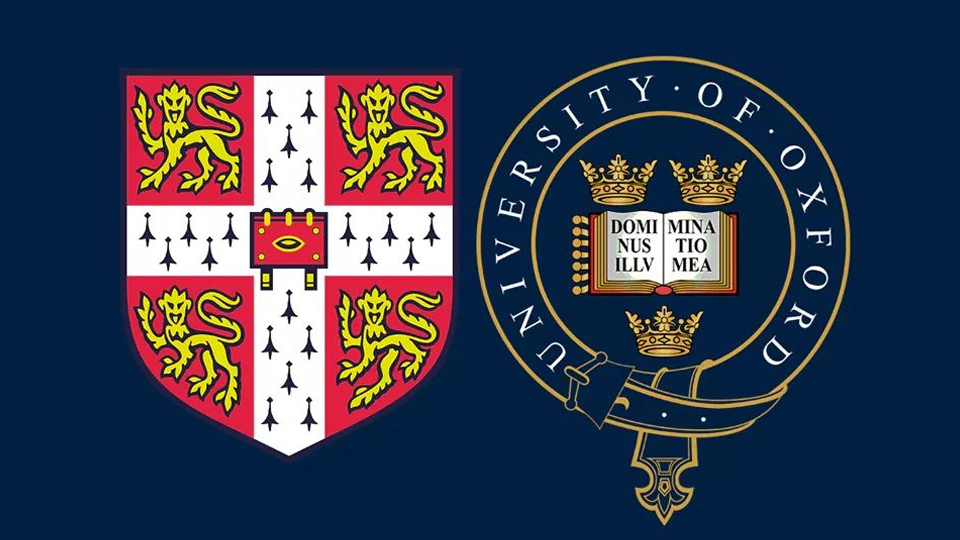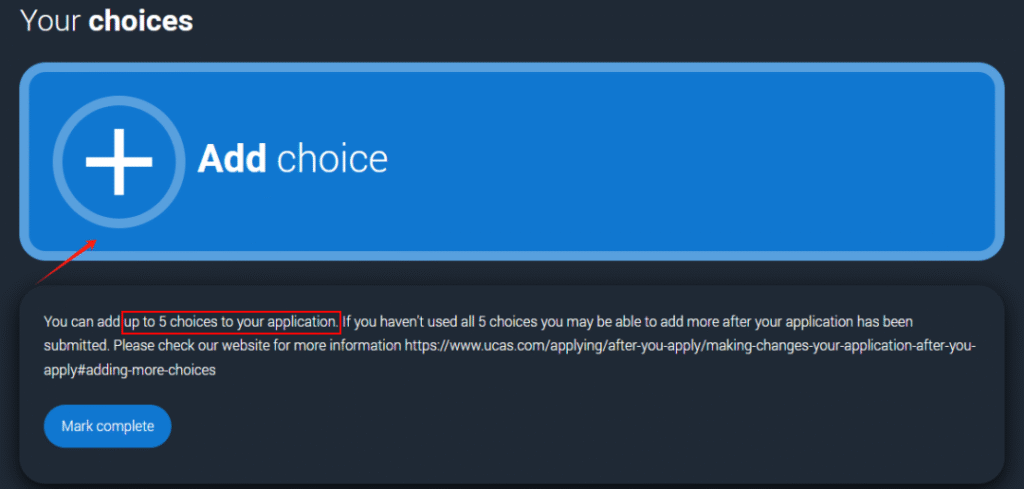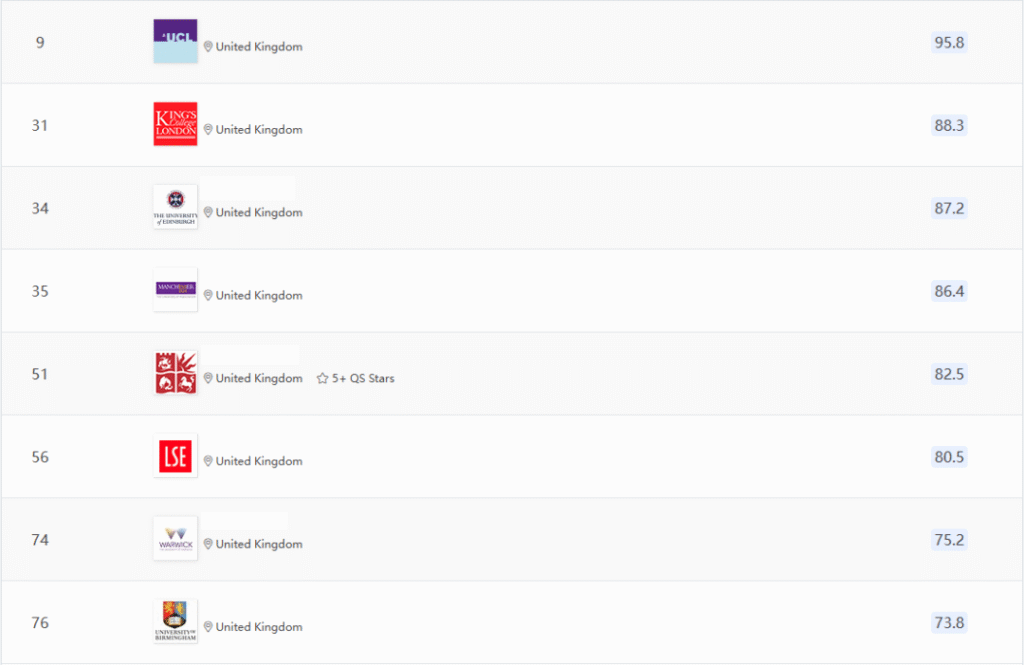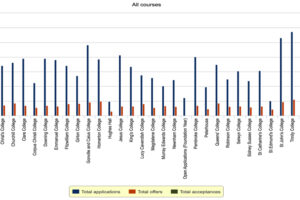
Fall 26 UK Undergraduate Application Strategy: How to Choose from Five Choices?
When submitting your UCAS application, you can only fill in a maximum of five choices. How should you best arrange these five choices
1.School Selection Strategy
University choices are about choosing the schools you hope to be accepted into. Careful planning is required to avoid a “all-inclusive” situation.

UCAS stipulates that you can add up to five choices when applying to a UK undergraduate program.
Ⅰ.Category of Choices: Target, Platform, and Safety
You can categorize your five choices into three types: target, platform, and safety.
Target: These schools have admission requirements that are slightly higher than your grades (predicted or actual). Admission is more difficult, but there’s a chance of a comeback, making them suitable for applying to higher-quality schools or programs. It’s recommended to choose one or two.
Platform: These schools have admission requirements that are similar to your grades (predicted or actual). As long as you perform well, your chances of acceptance are high. These are the schools you should prioritize when applying. It’s recommended to choose two or three.
Safety Schools: These schools have lower admission requirements than your predicted or actual scores, ensuring you’ll be accepted and avoiding the risk of a “full rejection.” It’s recommended to choose one or two schools.
Ⅱ.Institutional Tiers
We often categorize institutions into different tiers, creating a gradient.

As shown in the chart above, if Oxford and Cambridge are in the first tier, IC, LSE, and UCL are in the second tier, KCL、UoM、Edin、UoW are in the third tier, and the rest are in the fourth tier.
The definition of these tiers varies from person to person and region to region. For example, in the UK, St. Ann’s and Durham are considered top-tier universities, boasting high-quality teaching and graduating from many royal families.
In China, however, rankings are more important, and Bristol is considered superior because it’s ranked higher.
Regardless of your opinion of these institutions, they all possess significant global strength in some capacity.
Besides these universities, the UK itself has over a hundred schools, but universities ranked below 20 or 30 (except for arts programs or those with particularly strong programs) are not worth considering. The teaching quality of these universities is relatively average. Students with potential are advised to apply to better universities, even in Australia or Canada.
In the UK, authoritative university rankings include QS, The Times, and The Guardian.
These organizations rank universities based on comprehensive strength, reputation, research quality, and other factors, and update them annually.


Of course, these rankings have their flaws. For example, we rarely see the London School of Economics and Political Science (LSE) among the top-ranked universities. Does this mean that it is not as good as the top-ranked universities?
The answer is clearly no. Due to its strong focus on the social sciences, LSE suffers in comprehensive world university rankings, but this does not in any way diminish its strong strength in the social sciences.
Ⅲ.Specific Application Strategy
Oxford, Cambridge, Imperial College London, London School of Economics and Political Science, and University College London are generally considered in the first tier; these five schools are the top-tier.
The next tier includes King’s College London, the University of Manchester, the University of Edinburgh, and the University of Warwick, all of which also have high reputations.
Finally, there are a number of red brick universities and Russell Group universities, about 20 to 30 in total, which can serve as your backup schools.
If your top schools are Oxford and Cambridge, you can only choose one of these two (you cannot apply to both Oxford and Cambridge at the same time, and you can only apply to one program).
If your top schools are G5 universities other than Oxford and Cambridge, it’s best to choose no more than two. You can choose Imperial College London and University College London, or the London School of Economics and Political Science and University College London.
For platform schools, you can choose two to three from the first tier, such as Imperial College London and the London School of Economics and Political Science.
For backup schools, you can choose one or two from red brick universities and Russell Group schools.
This creates a three-tier application strategy.
If your goal isn’t the G5 universities of Oxford and Cambridge, you can also categorize your university applications into different tiers based on your individual skills and the caliber of the UK universities mentioned above.
2. Considerations for Choosing a University
Ⅰ.You cannot apply to both Oxford and Cambridge simultaneously.
You cannot apply to both universities simultaneously; you can only choose one.
This is because, if simultaneous applications were allowed, the number of applications to both institutions would surge, but the proportion of high-performing applicants would remain the same, and the university’s workload would increase.
Another point is that because Oxford and Cambridge use a collegiate system for admissions, the number of offers issued each year remains relatively consistent. If simultaneous applications were allowed, there would be a risk of wasted or insufficient places, making it difficult for the university to estimate its actual enrollment rate.
Ⅱ.It is not recommended to apply to multiple programs at the same university.
For example, Oxford and Cambridge only allow you to apply to one program.

Aside from Oxford and Cambridge, other UK universities allow you to apply to multiple programs.
For example, Imperial College London allows you to apply to multiple programs, but you must first discuss this with the university.

However, applying to multiple programs at the same university is still not recommended:
First, the number of offers is limited. Most universities also state that if you apply to multiple programs simultaneously, you can only accept one offer.
Second, it can affect the quality of your application. Most schools state that you can only submit one essay, and each essay is specific to a specific program. Applying to multiple programs will impact the quality of your essay.
Third, it won’t improve your chances of acceptance. If you apply to multiple programs at the same college, admissions officers may question your motivation, as your essay only demonstrates your interest in a single program.
Unless you have a compelling reason, avoid the risk.
Ⅲ.It’s recommended to choose the same program.
When applying through the UCAS system, focus solely on one program. Your essay, letters of recommendation, and background information can all be centered around this program.
Applying to different programs simultaneously can be challenging, as you’ll need to address two or more areas, resulting in fragmented content and making it difficult for admissions officers to assess your true interests and strengths.
Furthermore, British universities place a high value on academic potential, and admissions officers prefer students who demonstrate a long-term interest in and desire to explore their chosen program.
Conversely, applying to multiple programs simultaneously can be interpreted as “undefined interests” or “casting a wide net and trying to get ahead of yourself.” This perception can significantly reduce your chances of acceptance, especially in competitive admissions to top universities like Oxford and Cambridge.
Finally, every year, many students fail to receive offers due to poor school and major selection, and in some cases, are rejected entirely.
Therefore, it’s crucial to plan your application well in advance. Clarifying your interests, understanding which majors are best for you, and choosing the right schools based on your strengths are essential steps in the planning process.
Next, implement your application plan step by step according to your timeline to ensure a smooth application process.



